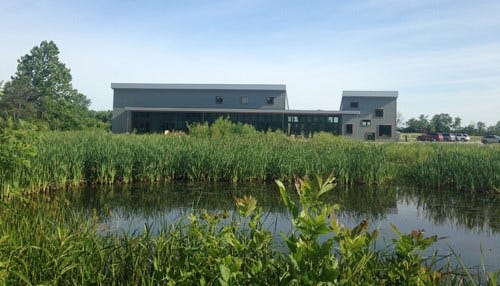Wayne County Ed Center Aims High for Environmental Success
 © The new Cope Environmental Center in Centerville
© The new Cope Environmental Center in Centerville
Subscriber Benefit
As a subscriber you can listen to articles at work, in the car, or while you work out. Subscribe NowAn east-central Indiana nonprofit that’s been educating children and adults alike on sustainable environmental practices for decades is on track for a rare recognition. The Cope Environmental Center (CEC) could soon be one of a handful of buildings in the United States to meet the Living Building Challenge (LBC), some of the most rigorous proven performance standards for buildings in the world.
Thousands of Hoosier school children visit the Cope Environmental Center near Centerville free of charge each year to learn about their native land and ways to care for it. Now the new Sustainable Education Center building is itself a teaching tool and part of the pursuit of the Living Building Challenge certification.
The original 30-acre farm was purchased by husband and wife educators Jim and Helen Cope in 1948. With the help of like-minded friend Francis Parks, they opened their environmental center to visiting students in 1992. Now at 130 acres and having outgrown the original farmhouse over the years, the center staff decided to start with fresh construction. They investigated Leadership in Energy and Environmental Design (LEED) construction, the Living Building Challenge and even the prospect of developing their own set of standards to which others in the region could aspire.
Kaitlyn Blansett is the CEC’s community outreach coordinator. She explains that while extraordinarily rigorous, the standards set by the Living Building Challenge suited the Center’s goals best.
“We’re an environmental center, so we wanted something a little more strict (than LEED), a little more focused. It’s not just a question of what we can do to help the environment, it’s a matter of what we can do when we’re occupying the building, how we can live more in harmony with nature even though we’re constructing a facility on this natural landscape.”
It’s been a long process. The CEC started feasibility tests for the LBC in 2008, then kicked off a capital campaign in 2012. Construction started in earnest in 2015, and the building was completed in December of 2016. The grand opening was held April 14 with the ceremonial planting of three Bur oaks in honor of the three founders.
The Living Building Challenge asks its participants to handle issues of environment and sustainability in the characterization of a flower, with each petal as a requirement to be met. The petals are site, water, energy, health, materials, equity and beauty. As the center took on the challenge, Blansett became a product researcher and is now managing the final stages of meeting the certification.
“One of the coolest things about our building is how we deal with energy. We have to meet net zero energy by the end of our one-year review, producing all of the energy we consume. We have solar panels and we have geothermal, but we wanted to focus on how to use less energy. One of the ways we do that is through passive solar. We designed the building to take in more solar by facing it south and angling it northwest, not only for light but also for heat. That part was free.”
Blansett says the CEC owes a debt of gratitude to local craftspeople who volunteered woodworking services and materials. A typical LBC building costs about $500 per square foot. The CEC averaged about $325 per square foot thanks to donated time and goods. The building features maple, oak, and walnut fixtures and includes a custom cherry handrail and ash desks with marks showing where ash borers did their damage.
“We also have an entire wall in our classroom that’s made out of plastic bottle caps that were melted down, turned into boards, then placed on the wall. We have the benches too, that are placed out along our trails.”
The new building also earns the CEC extra funds through use as an events center, but even that has an educational component. Blansett explains that anyone renting the property has to follow the recycling policy, both for the facility’s sake but also in hopes the process might take root at home as well.
Blansett is working to make sure all the criteria for the LBC petals are being met, documenting materials, working on correct water treatment at the site, and of course, managing energy. The April electric bill shows the facility returned twice the amount of power to White Water Valley REMC than it used, which is a good sign. If the Cope Environmental Center meets the requirements for the Living Building Challenge, it will be one of only seven to do so in the U.S. Blansett says she’s very hopeful that success is in sight.
